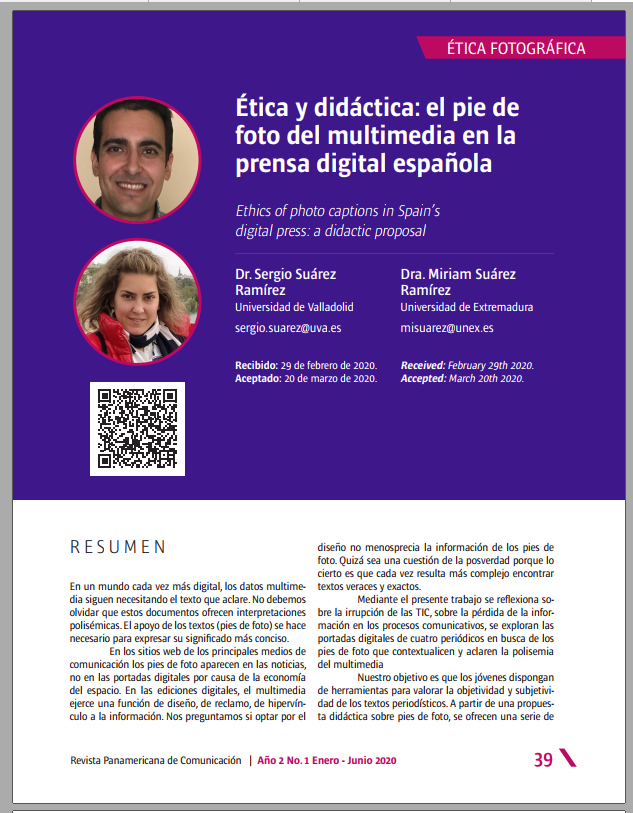Ethics of photo captions in Spain’s digital press: a didactic proposal
Main Article Content
Abstract
In a digital world, multimedia data needs a clarifying text, as these documents offer polysemic interpretations. Hence, the texts work as support to further develop the image’s necessarily concise meaning. The captions in media websites typically appear in the news pages, not on covers, owing to the limited space available. In digital editions, multimedia documents have a function related to design, the need to attract attention and provide a link to the content. In this respect, we wonder whether opting for design doesn’t underestimate the actual information provided by the photo caption. This may be a matter of post truth, as it is increasingly complex to find true and accurate texts. Through this work, we reflect on the irruption of ICT and on the loss of information in communicative processes. The digital front pages of four newspapers are explored in search of captions that contextualize and clarify the multimedia’s polysemic quality. Our goal is for young people to have tools to assess the objectivity and subjectivity of journalistic texts. This didactic proposal presents a series of activities offered to verify whether rhetorical mechanisms – appropriate to argumentative and literary discourse – play a key role in identifying misinformation in the post-truth era.
Article Details
References
Austin, J. (1988). Cómo hacer cosas con palabras. Barcelona: Editorial Paidós.
Barthes, R. (1972). “El mensaje fotográfico”, En Barthes, R. et al. La semiología. Buenos Aires: Tiempo Contemporáneo.
Benjamin, W. (1987). Pequeña historia de la fotografía. Madrid: Alfaguara.
Błachnio, A.; Przepiorka, A.; y Pantic, I. (2016). Association between Facebook addiction, self-esteem and life satisfaction: A cross-sectional study. Computers in Human Behavior, 55, 701-705.
Bühler, K. (1979). “Teoría del lenguaje”. En: Revista de Occidente. Madrid: Alianza.
Carr, N. (2008). “Google making us stupid?”. Revista The Atlantic. Consultado el 15/02/2020: https://www.theatlantic.com/magazine/archive/2008/07/is-google-making-us-stupid/306868/
Carrera, P. (2018). “Estratagemas de la posverdad”. Revista Latina de Comunicación Social, 73, 1469-1482.
Cartier-Bresson, H. (2003). Fotografiar del natural. Barcelona: Gustavo Gili.
Consell de la información de Catalunya. (2016). Codi Deontologic. Consultado el 14 de enero de 2020. Disponible en línea: https://fcic.periodistes.cat/es/codi-deontologic/
Del Valle Gastaminza, F. (2001). “El análisis documental de la fotografía”, SERVIDOC, Servicio de Documentación Multimedia del Departamento de Biblioteconomía y Documentación de la Universidad Complutense de Madrid.
Núñez Encabo, M. (1993). Código Deontológico Europeo de la Profesión Periodística. (Consultado el 07 de enero de 2020). Disponible en línea:
http://www.asociacionprensa.org/es/images/Codigo_Deontologico_Europeo_de_la_Profesion_Periodistica.pdf
El País, diario (2002). Manual de estilo. Madrid: Prisa. Consultado el 01/02/2020:
https://colecciones.elpais.com/index.php?controller=attachment&id_attachment=2
Federación de Asociaciones de Periodistas de España. (1993). Código Deontológico. Consultado el 3 de febrero de 2020. Disponible en línea: http://fape.es/home/codigo-deontologico/
Grau, A. (2008). Internet cambia la forma de leer, El País, Octubre, 10: http://elpais.com/diario/2008/10/10/sociedad/1223589601_850215.html (consultado 12/2011).
Grijelmo, Á. (1997). El estilo del periodista. Madrid: Taurus.
Habermas, J. (2012). “Teorías de la verdad”. En J. A. Nicolás y M. J. Frápolli (Eds.). Teorías contemporáneas de la verdad (pp. 625- 675). Madrid: Tecnos.
Harford, T. (2017). El problema con los hechos, Mercados Milenio. Consultado el 20 de enero de 2020. Disponible en línea: https://www.pressreader.com/mexico/milenio-mercados-milenio/20170320/281616715187173
Heredia Echavarri, M.; y González Díez, L. (2013). “La carencia del contexto escrito en la fotografía periodística: aproximación al uso del pie de foto en la prensa diaria chilena”. En Index.comunicación, nº3, pp.87-120.
Küpfer, N (1991). “Esa caprichosa mirada”. Revista de la Universidad Católica de Chile, nº 7, págs. 109-120.
Martín Aguado, J. ; Armentia, J. (1995): Tecnología de la información escrita. Madrid: Editorial Síntesis.
McIntyre, L. (2018), Post-Truth. Massachusetts: MIT Press.
Lerman, K.; y Ghosh, R.. (2010). Information contagion: an empirical study of spread of news on digg and twitter social networks. In Proceedings of 4th International Conference on Weblogs and Social Media (ICWSM).
Pisani, F. (2004). “Cómo lee el internauta en los sitios informativos”. Publicado el 14 de octubre de 2004 en la edición impresa de El País. Disponible en línea: https://elpais.com/diario/2004/10/14/ciberpais/1097718683_850215.html
Suárez Ramírez, S.. (2015). Los titulares en los cibermedios deportivos. Principales figuras retóricas y su aplicación didáctica. Tesis doctoral. Badajoz: Universidad de Extremadura.
Suárez Ramírez, S.; y Suárez Múñoz, Á. (2016). La retórica del titular deportivo en la prensa española. Documentación de las Ciencias de la Información, 39, pp. 83-118.
Suárez Ramírez, S.; Balça, Á.; Costa, P. (2018). La enseñanza de los textos deportivos. Estudio de las portadas impresas de España y Portugal. Contextos educativos, 22, pp. 45-62.
Turel, O.; He, Q.; Xue, G.; Xiao, L; y Bechara, A.. (2014). Examination of neural systems sub-serving Facebook “addiction”. Psychological Reports, 115(3), 675-695.
UNESCO (1983). Principios Internacionales de la Profesión Periodística. (consultado en 10 de enero de 2020). Disponible en línea: http://www.unesco.org/new/fileadmin/MULTIMEDIA/HQ/CI/CI/images/wmn/code%20of%20Ethics%20Collegio%20de%20periodistas.pdf
Van Dijk, T. (1996). La ciencia del texto. Barcelona: Paidós Comunicación.
Vázquez, K. (2011) “Sin tiempo para pensar”. Publicado el 31 de enero de 2011 en El País.
Vedwan, N. (2013). Does Facebook Make Us Happy? Happiness in an Age of Hyper- connectedness. Anthropology Now, 5(2), 87-92.
Vosoughi, S.; Roy, D.; y Aral, S. (2018). The spread of true and false news online. Science, 359(6380), 1146-1151.


